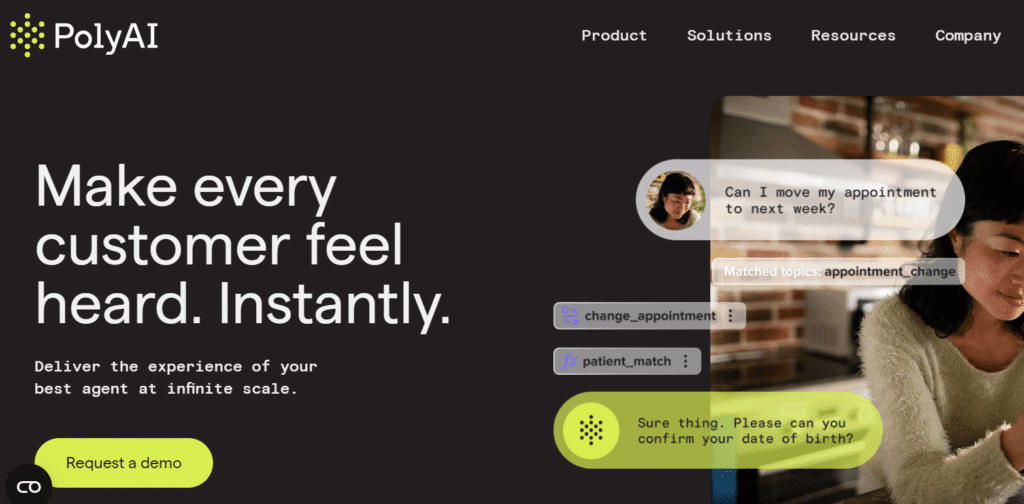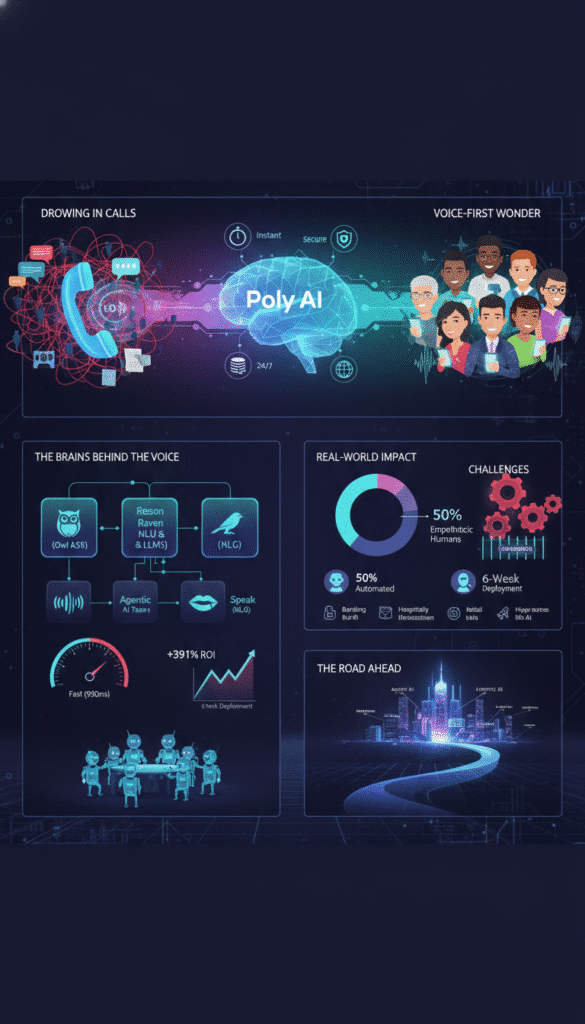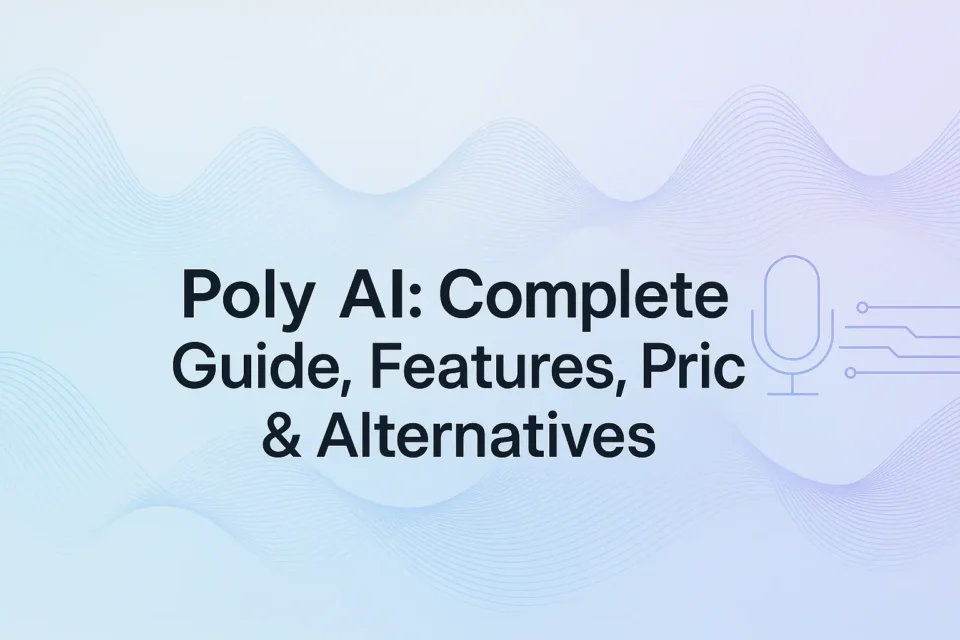Voice automation isn’t new. But here’s the thing, most of it still sounds… robotic. You know the drill: you call customer service, navigate through seven menu options, finally get to speak with a “virtual assistant” and within ten seconds you’re mashing zero trying to reach an actual person. That’s where Poly AI steps in, and honestly? They’re doing something different.
Founded by a team of Cambridge researchers who actually understand speech recognition and machine learning (not just marketing buzzwords), Poly AI has carved out a niche in the enterprise conversational AI space. Their focus isn’t on chatbots that fumble through text exchanges. It’s voice-first automation — the kind that handles real phone calls, with real customers, in real time. And apparently, it’s working. Companies using their platform have reported up to 391% ROI, according to a Forrester Total Economic Impact study.
So, what makes Poly AI worth paying attention to in 2025? Let’s dig into what they actually do, how their tech stacks up, where it works (and where it doesn’t), and whether this is the right fit for your enterprise contact center strategy.
What Is Poly AI?
Let’s start with the basics. Poly AI is a London-based company that builds conversational voice assistants specifically designed for enterprises. Think banks, hotels, utilities, retail giants, organizations that field thousands (sometimes millions) of inbound customer calls every month.

Their mission? Make every company sound human. Not “sort of human.” Not “good enough for simple queries.” Actually human — complete with natural pacing, interruptions, small talk, and the ability to handle messy, real-world conversations.
Here’s what sets them apart: most conversational AI platforms started with text-based chatbots and later tacked on voice capabilities. Poly AI went the other way. They built their entire architecture around voice from day one, optimizing for things like accent diversity, background noise, latency, and the unpredictable chaos of actual phone conversations.
The result? A platform that can automate customer service calls end-to-end without sounding like a 1990s IVR system (you know, the “press one for billing” nightmare).
A Brief History of Poly.ai: From Cambridge Labs to Customer Service Revolution
The Poly.AI story isn’t an overnight sensation. It’s a tale of academic rigor meeting real-world application.
- Brainiac Beginnings (2017): The company was founded in London by Nikola Mrkšić, Tsung-Hsien Wen, and Pei-Hao Su, all hailing from the University of Cambridge. Their backgrounds weren’t in customer service, but in the bleeding edge of spoken dialogue systems, with experience gleaned from giants like Apple (Siri), Google, and Facebook.
- The Big Pivot: Why Voice? Initially, like many in the space, they explored chatbots. But they quickly realized the untapped potential of their natural language understanding expertise for voice interactions. Their reasoning was deceptively simple, and profoundly insightful: customers will always call. So, instead of trying to eliminate phone calls, they set out to make that experience exceptional.
- Growth and Validation: Their vision resonated with investors. Poly .AI secured over $120 million in funding, culminating in a recent Series C round that valued the company at nearly $500 million. This funding fueled partnerships with over 100 enterprise clients, including recognizable names like FedEx, Marriott, and Allstate. Industry recognition followed, with Gartner naming them a “Cool Vendor” and Forbes including them on their AI 50 list.
Core Technology & How It Actually Works?
Okay, so how does this thing function under the hood?
Poly AI’s architecture revolves around three core components: speech recognition, natural language understanding (NLU), and dialog management. But it’s not just slapping together off-the-shelf tools from Google or Amazon. They’ve built proprietary models trained specifically for noisy, real-world phone audio.
Their speech recognition engine is designed to handle diverse accents — British, American, Australian, Indian, you name it — plus background noise like crying babies, traffic, or that person calling from a windy parking lot. Because let’s be honest, customer calls rarely happen in pristine recording studios.
The NLU layer then interprets what the caller actually means, not just what they say. Someone might ask “Where’s my stuff?” instead of “What is the status of my order?” The system gets it. Context matters.
Then there’s the dialog management piece, which is where things get interesting. Poly AI’s agents can handle interruptions (because humans interrupt), track context across multi-turn conversations, and even manage a bit of small talk when appropriate. If a customer says “Thanks, that helps,” the AI doesn’t just hang up — it responds naturally before closing the call.
Performance-wise? Sub-second response times, with end-to-end latency typically under 900 milliseconds. That’s fast enough that conversations feel natural, not like you’re talking to a laggy Zoom call.
And here’s the kicker: the system continuously improves through reinforcement learning. Every customer interaction feeds back into the model, refining accuracy, tone, and flow over time. So it actually gets better the more you use it (assuming you’re monitoring and tuning it, of course).
Integration-wise, Poly AI connects with existing telephony infrastructure — think Azure, Genesys, Twilio — and plugs into CRM systems so the AI can pull customer data in real time. No rip-and-replace required. Just APIs and some configuration work.

Where Does Poly AI Actually Get Used?
Theory is great. But where does this platform shine in the real world?
- Contact centers are the obvious one. If you’re handling 100,000+ inbound calls a month with questions like “Where’s my order?” or “I need to reset my password,” Poly AI can offload a massive chunk of that volume. One Forrester case study found that enterprises using Poly AI automated 50% of their routine queries, cutting average handle time by over 40%.
- Hospitality is another big vertical. Hotels use Poly AI to automate reservation changes, check-in confirmations, and concierge requests. Imagine calling the front desk at 2 a.m. to ask about pool hours or request extra towels — and getting an instant, accurate answer without waking up a human employee.
- Banking and financial services are leaning into this too. Voice bots handle account balance inquiries, lost card reports, and even basic authentication flows. It’s faster than waiting on hold, and for low-risk queries, it’s just as effective as speaking to a human agent.
- Utilities (think electric, gas, water companies) use Poly AI for payment reminders, outage updates, and meter reading coordination. Not glamorous, but incredibly high-volume — perfect for automation.
And retail brands deploy it for order tracking, returns processing, and loyalty program support. If your call center is drowning in “Where’s my package?” calls during the holidays, this kind of automation is a lifesaver.
Here’s a quick snapshot:
| Industry | Typical Use Case | Key Benefit | Automation Rate |
| Contact Centers | Routine queries, password resets | Reduced handle time, 24/7 availability | 50–60% |
| Hospitality | Reservations, concierge, check-ins | Instant response, multilingual support | 40–50% |
| Banking | Balance checks, card reports | Secure, compliant, fast resolution | 45–55% |
| Utilities | Payment reminders, outage updates | High-volume automation | 50–70% |
| Retail | Order tracking, returns | Peak-season scalability | 40–60% |
Poly.ai – Create AI Chat Bot: Benefits
Let’s talk upside first.
- Cost savings are significant. If you’re paying contact center agents $15–$20/hour and handling tens of thousands of calls monthly, automating even 40% of that volume adds up fast. Forrester’s study estimated a 391% ROI over three years for a composite enterprise using Poly AI. That’s not pocket change.
- 24/7 availability without burnout. Your AI agents don’t need breaks, vacations, or sleep. Midnight query? Handled. Holiday weekend surge? No problem.
- Consistency across every interaction. Human agents have good days and bad days. AI doesn’t. Every caller gets the same quality of service, the same tone, the same level of accuracy.
- Seamless integration with existing systems. You’re not ripping out your entire telephony stack. Poly AI layers on top of what you already have.
- Agent productivity boost. When AI handles the repetitive stuff, your human agents get to focus on complex, high-value interactions where empathy and creativity actually matter.
But let’s not pretend it’s all sunshine. There are challenges.
Challenges of Poly AI Chatbot
- Upfront investment isn’t trivial. Custom enterprise pricing typically starts around $100K–$200K annually, depending on call volume and complexity. That’s not a plug-and-play SaaS subscription.
- Deployment takes time. Figure 6–8 weeks minimum for a full rollout, especially if you’re integrating with legacy CRM or telephony systems. This isn’t a weekend project.
- Accuracy requires ongoing tuning. Out of the box, the system is good — but not perfect. You’ll need to monitor transcripts, adjust dialog flows, and train the model on edge cases. It’s not “set it and forget it.”
- Regulatory hurdles in some industries. Banking and healthcare, especially, have strict compliance requirements around AI-driven customer interactions. You’ll need legal and compliance buy-in before you flip the switch.
Start with a pilot. Pick one high-volume, low-complexity use case (like order tracking), run it for 60–90 days, measure results, then scale. Don’t try to automate everything at once.
What Does Poly AI Actually Cost?
Pricing transparency in enterprise AI? Rare. But here’s what we know.
Poly AI operates on a custom pricing model, typically structured as pay-per-minute or per-call with enterprise support SLAs. Annual contracts generally range from $100K to $200K+, depending on factors like:
- Call volume (how many thousands or millions of calls per month)
- Call complexity (simple FAQs vs. multi-turn problem-solving)
- Number of languages supported
- Integration requirements (CRM, telephony, analytics)
- Level of customization (voice persona, brand tone, dialog scripting)
According to the Forrester study, enterprises can expect payback within 6–12 months if automation rates hit 40–50%. That ROI benchmark of 391% over three years factors in cost savings from reduced agent labor, improved customer satisfaction, and faster issue resolution.
How does that compare to alternatives? Most competitors (like Voiceflow or Kore.ai) use subscription pricing models, which can be cheaper upfront but may lack the enterprise-grade voice quality and telephony integrations that Poly AI offers. You’re paying for specialization here.
| Factor | Poly AI | Typical Alternative | Notes |
| Pricing model | Custom, per-minute | Subscription | Enterprise scale focus |
| Deployment time | 6–8 weeks | 2–4 weeks | Poly AI for complex pipelines |
| Ideal client | Enterprise (100K+ calls/mo) | SMB to mid-market | Volume-driven value prop |
How Does Poly AI Stack Up Against Competitors?
Let’s talk alternatives, because Poly AI isn’t the only player in this space.
Voiceflow:
Voiceflow is popular for text-first conversational design with some voice add-ons, but it’s geared more toward mid-market and SMBs. If you’re a startup or small business building a voice assistant, Voiceflow’s no-code interface is appealing. But if you’re fielding half a million calls a month and need sub-second latency with accent diversity? Poly AI is built for that.
Cognigy
Cognigy offers omnichannel automation (voice + chat + messaging), which sounds great in theory. But their voice capabilities aren’t as specialized as Poly AI’s. If you need a jack-of-all-trades platform, Cognigy might fit. If voice is your priority? Poly AI wins on audio quality and latency.
Kore.ai and Google CCAI
Kore.ai and Google CCAI (Contact Center AI) are also in the mix. Kore leans heavily into enterprise integrations; Google brings brand recognition and cloud infrastructure. But neither matches Poly AI’s laser focus on natural-sounding, voice-first interactions.
Decision checklist: Should you consider Poly AI?
- Are you handling 100K+ voice calls per month? (If no, you might not need enterprise-grade voice AI yet.)
- Is multilingual, accent-diverse voice essential? (Poly.AI excels here.)
- Do you need human-like intonation and conversational flow? (This is their differentiator.)
- Are you enterprise-scale with strict security and compliance needs? (Poly AI is built for this.)
If you answered “yes” to most of those, Poly AI is worth a serious look. If you’re more focused on text chat or have lower call volumes, there are lighter-weight alternatives.
How to Actually Implement This (Without Losing Your Mind)?
Rolling out conversational AI isn’t plug-and-play. Here’s a realistic roadmap.
Step 1: Define your customer intents and call flows. What are the top 10–20 reasons people call you? Map those out. Be specific.
Step 2: Choose your voice persona. Tone, gender, regional accent — this matters more than you think. A friendly, conversational tone works for retail; a professional, neutral tone fits banking better.
Step 3: Integrate with your CRM and IVR system. Poly AI needs to pull customer data (order history, account details) in real time. Work with your IT and telephony teams early.
Step 4: Train and test with real customer data. Use historical call transcripts to train the model. Run simulations. Test edge cases.
Step 5: Launch with a pilot cohort. Don’t go live across your entire call center on day one. Pick one segment, monitor closely, iterate.
Step 6: Optimize continuously using analytics. Track KPIs like average handle time (AHT), containment rate, customer satisfaction (CSAT), and drop-off points. Adjust scripts and flows based on what the data tells you.
Pro tips from the field:
- Get buy-in from your CX and operations teams early. If they feel left out of the design process, you’ll face internal resistance.
- Pay close attention to the handoff experience between AI and human agents. Clunky transitions kill customer satisfaction.
- Monitor drop-off rates obsessively. If 30% of callers are bailing mid-conversation, your dialog flow needs work.
Where Is Voice AI Headed Next?
The conversational AI market is growing fast — projections estimate it’ll hit $136 billion by 2035, up from around $12 billion today. That’s a compound annual growth rate (CAGR) of roughly 24%.
What’s driving that growth?
Agentic AI is one big shift. Instead of just responding to queries, next-gen voice agents will make autonomous decisions — like proactively offering refunds, rebooking appointments, or escalating issues without explicit user prompts. Think less “FAQ bot,” more “AI customer service rep with actual judgment calls.”
Emotional tone detection is another frontier. Future systems will analyze vocal cues (stress, frustration, satisfaction) and adapt their responses accordingly. If you sound angry, the AI shifts tone, offers empathy, maybe escalates faster.
Omnichannel blending is becoming table stakes. Customers expect to start a conversation on the phone, continue via SMS, and finish in a web chat — all without repeating themselves. Voice AI platforms that can’t do this will get left behind.
Predictive personalization using past interactions is also coming. Imagine calling a hotel and the AI already knows you prefer a king bed, quiet floor, and late checkout based on previous stays. That’s not sci-fi anymore — it’s happening now.
Also find the key differences between: Agentic AI vs Generative AI vs Traditional AI
So, Should You Actually Use Poly AI?
Look, here’s the deal. Poly AI isn’t for everyone. If you’re a small business with a couple hundred calls a month, this is overkill. But if you’re an enterprise drowning in repetitive customer service calls, burning cash on agent labor, and trying to scale without sacrificing quality? This is one of the most credible solutions out there.
The tech is solid. The ROI is proven. The voice quality is legitimately good — not “good for AI,” just… good. And the platform integrates with existing systems, which matters more than people realize.
But you’ll need patience, budget, and a willingness to iterate. This isn’t magic. It’s engineering. And like all engineering, it takes time to tune.
Next steps?
If you’re serious about exploring this, start with a business case. Calculate your current cost per call. Estimate what 40–50% automation would save you. Then talk to Poly AI (or a competitor) about a pilot project. Don’t commit to a full rollout until you’ve tested it in your specific environment.
And if you want to stay ahead of where voice AI is going — agentic agents, emotional detection, omnichannel everything — now’s the time to start paying attention. Because this space is moving fast, and early movers are building real competitive advantages.
FAQs
Poly AI automates enterprise phone-based customer interactions — think contact center queries, hospitality reservations, banking support, and utility updates.
Poly AI is voice-first and enterprise-focused, built for high-volume call centers with complex telephony integrations. Voiceflow is more text-focused, no-code, and geared toward SMBs.
Probably not. The pricing (typically $100K+ annually) and deployment complexity make it a better fit for enterprises handling 100K+ calls per month.
Hospitality, banking, utilities, retail, and contact centers are the big ones.
Custom pricing, usually $100K–$200K+ annually depending on call volume, complexity, and integrations.
Expect 6–8 weeks for a full deployment, including integration, training, and testing.
Enterprise-grade security with compliance support for industries like banking and healthcare, though specific certifications vary by deployment.


